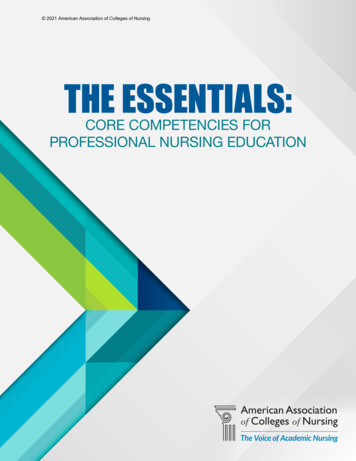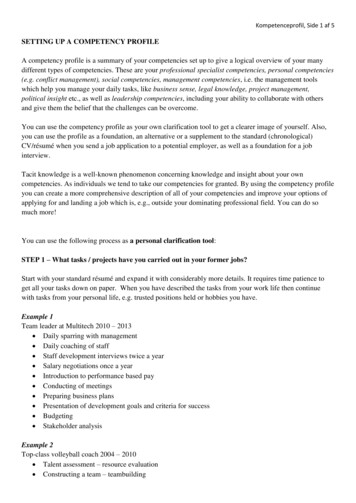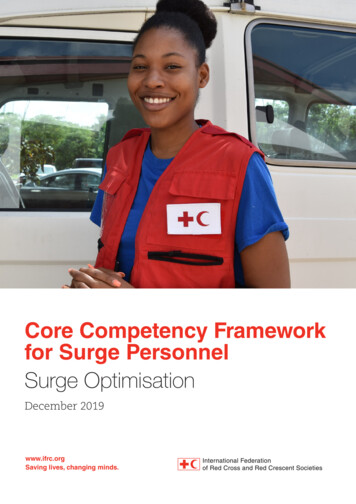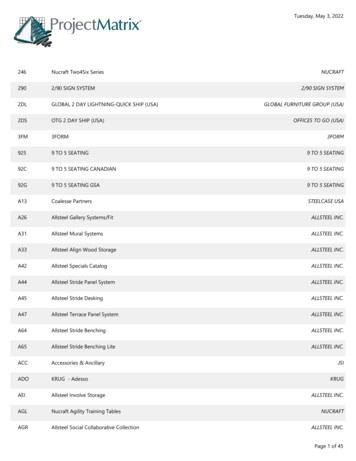
Transcription
2021 American Association of Colleges of NursingTHE ESSENTIALS:CORE COMPETENCIES FORPROFESSIONAL NURSING EDUCATION
2021 American Association of Colleges of NursingTHE ESSENTIALS:CORE COMPETENCIES FORPROFESSIONAL NURSING EDUCATIONAPPROVED BY THE AACN MEMBERSHIP ON APRIL 6 , 2021COPYRIGHT 2021 AMERICAN ASSOCIATION OF COLLEGES OF NURSING.ALL RIGHTS RESERVED. NO PART OF THIS PUBLICATION MAY BE REPRODUCEDIN PRINT, BY PHOTOSTATIC MEANS, OR IN ANY OTHER MANNER, WITHOUT THEEXPRESSED WRITTEN PERMISSION OF THE ASSOCIATION.
2021 American Association of Colleges of Nursing
2021 American Association of Colleges of NursingThe Essentials: Core Competencies for Professional Nursing EducationApril 6, 2021TABLE OF CONTENTSIntroduction. 1Foundational Elements. 2Nursing Education for the 21st Century. 5Domains and Concepts. 10Domains for Nursing. 10Concepts for Nursing Practice. 11Competencies and Sub-Competencies. 15A New Model for Nursing Education. 16Implementing the Essentials: Considerations for Curriculum. 18Entry-Level Professional Nursing Education. 19Advanced-Level Nursing Education. 21Domains, Competencies, and Sub-Competencies for Entry-level Professional NursingEducation and Advanced-level Nursing Education. 271. Knowledge for Nursing Practice. 272. Person-Centered Care. 293. Population Health. 334. Scholarship for the Nursing Discipline. 375. Quality and Safety. 396. Interprofessional Partnerships. 427. Systems-Based Practice. 448. Informatics and Healthcare Technologies. 469. Professionalism. 4910. Personal, Professional, and Leadership Development. 53Glossary. 55Reference List. 67Essentials Task Force. 75THE ESSENTIALS: CORE COMPETENCIES FOR PROFESSIONAL NURSING EDUCATIONiii
2021 American Association of Colleges of Nursing
2021 American Association of Colleges of NursingThe Essentials: Core Competencies forProfessional Nursing EducationIntroductionSince 1986, the American Association of Colleges of Nursing (AACN) has published theEssentials series that provides the educational framework for the preparation of nurses atfour-year colleges and universities. In the past, three versions of Essentials were published:The Essentials of Baccalaureate Education for Professional Nursing Practice, last published in2008; The Essentials of Master’s Education in Nursing, last published in 2011; and The Essentialsof Doctoral Education for Advanced Nursing Practice, last published in 2006. Each of thesedocuments has provided specific guidance for the development and revision of nursing curriculaat a specific degree level. Given changes in higher education, learner expectations, and therapidly evolving healthcare system outlined in AACN’s Vision for Academic Nursing (2019), newthinking and new approaches to nursing education are needed to prepare the nursing workforceof the future.The Essentials: Core Competencies for Professional Nursing Education provides a framework forpreparing individuals as members of the discipline of nursing, reflecting expectations acrossthe trajectory of nursing education and applied experience. In this document competenciesfor professional nursing practice are made explicit. These Essentials introduce 10 domains thatrepresent the essence of professional nursing practice and the expected competencies for eachdomain (see page 26). The domains and competencies exemplify the uniqueness of nursingas a profession and reflect the diversity of practice settings yet share common language thatis understandable across healthcare professions and by employers, learners, faculty, and thepublic. The competencies accompanying each domain are designed to be applicable across fourspheres of care (disease prevention/promotion of health and wellbeing, chronic disease care,regenerative or restorative care, and hospice/palliative/supportive care), across the lifespan,and with diverse patient populations. While the domains and competencies are identical forboth entry and advanced levels of education, the sub-competencies build from entry intoprofessional nursing practice to advanced levels of knowledge and practice. The intent is thatany curricular model should lead to the ability of the learner to achieve the competencies. TheEssentials also feature eight concepts that are central to professional nursing practice and areintegrated within and across the domains and competencies.Because this document has been shared with practice partners and with other nursingcolleagues, the Essentials serve to bridge the gap between education and practice. The corecompetencies are informed by the expanse of higher education, nursing education, nursingas a discipline, and a breadth of knowledge. The core competencies also are informed by thelived experiences of those deeply entrenched in various areas where nurses practice and thesynthesis of knowledge and action intersect. The collective understanding allows all nursesto have a shared vision; promotes open discourse and exchange about nursing practice; andexpresses a unified voice that represents the nursing profession.This introduction provides an overview of the evolution of nursing as a discipline, criticalaspects of the profession that serve as a framework, and sufficient depth to inform nursingeducation across the educational trajectory (entry into practice through advanced education).THE ESSENTIALS: CORE COMPETENCIES FOR PROFESSIONAL NURSING EDUCATION1
2021 American Association of Colleges of NursingSpecific citations throughout provide immediate access to pertinent references thatsubstantiate relevancy.Foundational ElementsThe Essentials: Core Competencies for Professional Nursing Education has been built on thestrong foundation of nursing as a discipline, the foundation of a liberal education, and principlesof competency-based education.Nursing as a DisciplineThe Essentials, as the framework for preparing nursing’s future workforce, intentionally reflectand integrate nursing as a discipline. The emergence of nursing as a discipline had its earliestroots in Florence Nightingale’s thoughts about the nature of nursing. Believing nursing to beboth a science and an art, she conceptualized the whole patient (mind, body, and spirit) asthe center of nursing’s focus. The influence of the environment on an individual’s health andrecovery was of utmost importance. The concepts of health, healing, well-being, and theinterconnectedness with the multidimensional environment also were noted in her work.Although Nightingale did not use the word “caring” explicitly, the concept of care and acommitment to others were evident through her actions (Dunphy, 2015). In the same era ofFlorence Nightingale, nurse pioneer Mary Seacole was devoted to healing the wounded duringthe Crimean war.Following Nightingale, the nursing profession underwent a period of disorganization andconfusion as it began to define itself as a distinct scientific discipline. Early nursing leaders(including Mary Eliza Mahoney, Effie Taylor, Annie Goodrich, Agatha Hodgins, EstherLucille Brown, and Loretta Ford) sought to define the functions of the nurse (Gunn, 1991;Keeling, Hehman, & Kirchgessner, 2017). Other leaders devoted their efforts to addressingdiscrimination, advancing policies, and creating a collective voice for the profession. It wouldbe difficult to gain an understanding of this period of the profession’s development withoutconsidering the work of Lavinia Dock, Estelle Osborne, Mary Elizabeth Carnegie, Ildaura MurilloRohde, and many other fearless champions.Contemporary nursing as it is practiced today began to take shape as a discipline in the1970s and 1980s. Leaders of this era shared the belief that the discipline of nursing was thestudy of the well-being patterning of human behavior and the constant interaction withthe environment, including relationships with others, health, and the nurse (Rogers, 1970;Donaldson & Crowley, 1978; Fawcett, 1984; Chinn & Kramer 1983, 2018; Chinn, 2019; Roy &Jones, 2007). The concept of caring also was described as the defining attribute of the nursingdiscipline (Leininger, 1978; Watson, 1985). Newman (1991) spoke to the need to sharpen thefocus of the discipline of nursing to better define its social relevance and the nature of itsservice. Newman, Smith, Pharris, and Jones (2008) affirmed caring as the focus of the discipline,suggesting that relationships were the unifying construct. Smith and Parker (2010) later positedthat relationships were built on partnership, presence, and shared meaning.In a historical analysis of literature on the discipline of nursing, five concepts emerged asdefining the discipline: human wholeness; health; healing and well-being; environment-healthrelationship; and caring. When practicing from a holistic perspective, nurses understand the2THE ESSENTIALS: CORE COMPETENCIES FOR PROFESSIONAL NURSING EDUCATION
2021 American Association of Colleges of Nursingdynamic, ongoing body-brain-mind-spirit interactions of the person, between and amongindividuals, groups, communities, and the environment (Smith, 2019, pp. 9-12). Smith purportsthat if nursing is to retain its status as a discipline, the explicit disciplinary knowledge must be anintegral part of all levels of nursing. Nursing has its own science, and this body of knowledge isfoundational for the next generation (Smith, 2019, p.13).Why consider the past in a document that strives to shape the future? The historical roots ofthe profession help its members understand how the past has answered complex questionsand shapes vital discipline concepts, traditions, policies, and even relationships. D’Antonio, et.al (2010) also emphasize the disciplinary insights gained by considering the different historiesthat challenge the dominant and accepted historical narrative. Undoubtedly, many experts havecontributed to the development of the discipline as it exists today. While the work of early andcurrent theorists is extensive, Green (2018) notes that none have been accepted as completelydefining the nature of nursing as a discipline. No doubt, nursing as a discipline will continue toevolve as society and health care evolves.Advancing the Discipline of NursingThe continued development of nursing as a unique discipline requires an intentional approach.Jairath et. al (2018) stated that any further development of the discipline should have thecapacity to directly transform the patient’s health experience. A new social order may benecessary in which scientists, theorists, and practitioners work together to address questionsrelated to the interplay of big data and nursing theory. Nursing graduates, particularly atthe advanced nursing practice level, must be well-prepared to think ethically, conceptually,and theoretically to better inform nursing care. Students must not only be introduced to theknowledge and values of the discipline, but they must be guided to practice from a disciplinaryperspective – by seeing patients through the lens of wholeness and interconnectedness withfamily and community; appreciating how the social, political, and economic environmentinfluences health; attending to what is most important to well-being; developing a caringhealing relationship; and honoring personal dignity, choice, and meaning. Smith and McCarthy(2010) spoke to the need to provide a foundation for practitioners in the knowledge of thediscipline. Without this knowledge, the persistent challenge of differentiating nursing and theprofessional levels of practice will continue.Knowledge of the discipline grows in graduate education, as students apply and generatenursing knowledge in their advanced nursing roles or develop and test theories as researchers.Nursing practice should be guided by a nursing perspective while functioning within aninterdisciplinary arena. To appropriately educate the next generation of nurses, disciplinaryknowledge must be leveled to reflect the competencies or roles expected at each level.The Value of a Liberal EducationIn higher education, every academic discipline is grounded in a unique body of knowledge thatdistinguishes that discipline. Through the study of the humanities, social sciences, and naturalsciences, students develop the capacity to engage in socially valued work and civic leadership insociety. Liberal education exposes students to a broad worldview, multiple disciplines, and waysof knowing through specific coursework; however, the richness of perspective and knowledgeis woven throughout the nursing curriculum as these are integral to the full scope of nursingTHE ESSENTIALS: CORE COMPETENCIES FOR PROFESSIONAL NURSING EDUCATION3
2021 American Association of Colleges of Nursingpractice (Hermann, 2004). Successful integration of liberal and nursing education providesgraduates with knowledge of human cultures, including spiritual beliefs, as well as the physicaland natural worlds supporting an approach to practice. The study of history, critical racetheories, critical theories of nursing, critical digital studies, planetary health and climate science,politics, public policies, policy formation, fine arts, literature, languages, and the behavioral,biological, and natural sciences are key to the understanding of one’s self and others, civilreadiness, and engagement and forms the basis for clinical reasoning and subsequentclinical judgments.A liberal education creates the foundation for intellectual and practical abilities within thecontext of nursing practice as well as for engagement with the larger community, locallyand globally. A hallmark of liberal education is the development of a personal value systemthat includes the ability to act ethically regardless of the situation and where students areencouraged to define meaningful personal and professional goals with a commitment tointegrity, equity, and social justice. Liberally educated graduates are well prepared to integrateknowledge, skills, and values from the arts, sciences, and humanities to provide safe, qualitycare; advocate for patients, families, communities, and populations; and promote health equityand social justice. Equally important, nursing education needs to ensure an understanding ofthe intersection of bias, structural racism, and social determinants with healthcare inequitiesand promote a call to action.Competency-Based EducationCompetency-based education is a process whereby students are held accountable to themastery of competencies deemed critical for an area of study. Competency-based educationis inherently anchored to the outputs of an educational experience versus the inputs of theeducational environment and system. Students are the center of the learning experience,and performance expectations are clearly delineated along all pathways of education andpractice. Across the health professions, curriculum, course work, and practice experiencesare designed to promote responsible learning and assure the development of competenciesthat are reliably demonstrated and transferable across settings. By consistently assessingtheir own performance, students develop the ability to reflect on their own progress towardsthe achievement of learning goals and the ongoing attainment of competencies requiredfor practice.Advances in learning approaches and technologies, understanding of evolving student learningstyles and preferences, and the move to outcome-driven education and assessment all pointto a transition to competency-based education. This learning approach is linked to explicitlydefined performance expectations, based on observable behavior, and requires frequentassessment using diverse methodologies and formats. Designed in this fashion, competencybased education produces learning and behavior that endures, since it encourages consciousconnections between knowledge and action. Learners who put knowledge into action graspthe interrelatedness of their learning with both theoretical perspectives and the world of theirprofessional work. Achieving a specific competency gives meaning to the theoretical and assistsin understanding and taking on a professional identity.Further, today’s students increasingly are taking responsibility for their own learning and, variedas they are in age and experience, respond to active learning strategies. Active learning involves4THE ESSENTIALS: CORE COMPETENCIES FOR PROFESSIONAL NURSING EDUCATION
2021 American Association of Colleges of Nursingmaking an action out of knowledge—using knowledge to reflect, analyze, judge, resolve,discover, interact, and create. Active learning requires clear information regarding what is tobe learned, including guided practice in using that information to achieve a competency. Italso requires regular assessment of progress towards mastery of the competency and frequentfeedback on successes and areas needing development. Additionally, students must learnhow to assess their own performances to develop the skill of continual self-reflection in theirown practice.Stakeholders (employers, students, and the public) expect all nursing graduates to exit theireducation programs with defined and observable skills and knowledge. Employers desireassurance that graduates have expected competencies—the ability “to know” and also “to do”based on current knowledge. Moving to a competency-based model fosters intentionality oflearning by defining domains, associated competencies, and performance indicators for thosecompetencies. Currently, there is wide variability in graduate capabilities. Therefore, there is aneed for consistency enabled by a competency-based approach to nursing education.A standard set of definitions frame competency-based education in the health professions andwas adopted for these Essentials. Adoption of common definitions allows multiple stakeholdersinvolved in health education and practice to share much of the same language. Thesedefinitions are included in the glossary (p. 59).Nursing Education for the 21st CenturyIn addition to the foundational elements on which the Essentials has been developed, otherfactors have served as design influencers. What does the nursing workforce need to look likefor the future, and how do nursing education programs prepare graduates to be “work ready”?Nursing education for the 21st century ought to reflect a number of contemporary trends andvalues and address several issues to shape the future workforce, including diversity, equity, andinclusion; four spheres of care (including an enhanced focus on primary care); systems-basedpractice; informatics and technology; academic-practice partnerships; and career-long learning.Diversity, Equity, and InclusionShifting U.S. population demographics, health workforce shortages, and persistent healthinequities necessitate the preparation of nurses able to address systemic racism and pervasiveinequities in health care. The existing inequitable distribution of the nursing workforceacross the United States, particularly in underserved urban and rural areas, impacts accessto healthcare services across the continuum from health promotion and disease prevention,to chronic disease management, to restorative and supportive care. Diversity, equity, andinclusion—as a value—supports nursing workforce development to prepare graduates whocontribute to the improvement of access and care quality for underrepresented and medicallyunderserved populations (AACN, 2019). Diversity, equity, and inclusion require intentionality,an institutional structure of social justice, and individually concerted efforts. The integrationof diversity, equity, and inclusion in this Essentials document moves away from an isolatedfocus on these critical concepts. Instead, these concepts, defined in competencies, arefully represented and deeply integrated throughout the domains and expected in learningexperiences across curricula.THE ESSENTIALS: CORE COMPETENCIES FOR PROFESSIONAL NURSING EDUCATION5
2021 American Association of Colleges of NursingMaking nursing education equitable and inclusive requires actively combating structuralracism, discrimination, systemic inequity, exclusion, and bias. Holistic admission reviews arerecommended to enhance the admission of a more diverse student population to the profession(AACN, 2020). Additionally, an equitable and inclusive learning environment will support therecruitment, retention, and graduation of nursing students from disadvantaged and diversebackgrounds. Diverse and inclusive environments allow examination of any implicit or explicitbiases, which can undermine efforts to enhance diversity, equity, and inclusion. When diversityis integrated within inclusive educational environments with equitable systems in place, biasesare examined, assumptions are challenged, critical conversations are engaged, perspectivesare broadened, civil readiness and engagement are enhanced, and socialization occurs. Theseenvironments recognize the value of and need for diversity, equity, and inclusion to achieveexcellence in teaching, learning, research, scholarship, service, and practice.Academic nursing must address structural racism, systemic inequity, and discrimination inhow nurses are prepared. Nurse educators are called to critically evaluate policies, processes,curricula, and structures for homogeneity, classism, color-blindness, and non-inclusiveenvironments. Evidence-based, institution-wide approaches focused on equity in studentlearning and catalyzing culture shifts in the academy are fundamental to eliminating structuralracism in higher education (Barber et al., 2020). Only through deconstructive processescan academic nursing prepare graduates who provide high quality, equitable, and culturallycompetent health care.Finally, nurses should learn to engage in ongoing personal development towards understandingtheir own conscious and unconscious biases. Then, acting as stewards of the profession, theycan fulfill their responsibility to influence both nursing and societal attitudes and behaviorstoward eradicating structural/systemic racism and discrimination and promoting social justice.Four Spheres of CareHistorically, nursing education has emphasized clinical education in acute care. Looking atcurrent and future needs, it is becoming increasingly evident that the future of healthcaredelivery will occur within four spheres of care: 1) disease prevention/promotion of health andwell-being, which includes the promotion of physical and mental health in all patients as wellas management of minor acute and intermittent care needs of generally healthy patients;2) chronic disease care, which includes management of chronic diseases and prevention ofnegative sequelae; 3) regenerative or restorative care, which includes critical/trauma care,complex acute care, acute exacerbations of chronic conditions, and treatment of physiologicallyunstable patients that generally requires care in a mega-acute care institution; and 4) hospice/palliative/supportive care, which includes end-of-life care as well as palliative and supportivecare for individuals requiring extended care, those with complex, chronic disease states, orthose requiring rehabilitative care (Lipstein et al., 2016; AACN, 2019).Entry-level professional nursing education ensures that graduates demonstrate competenciesthrough practice experiences with individuals, families, communities, and populations acrossthe lifespan and within each of these four spheres of care. The workforce of the future needsto attract and retain registered nurses who choose to practice in diverse settings, includingcommunity settings to sustain the nation’s health. Expanding primary care into communitieswill enable our healthcare delivery systems to achieve the Quadruple Aim of improving patient6THE ESSENTIALS: CORE COMPETENCIES FOR PROFESSIONAL NURSING EDUCATION
2021 American Association of Colleges of Nursingexperiences (quality and satisfaction), improving the health of populations, decreasing percapita costs of health care, and improving care team well-being (Bowles et al., 2018). It is timefor nursing education to refocus and move beyond some long-held beliefs such as: primary carecontent is not important because it is not on the national licensing exam for registered nurses;students only value those skills required in acute care settings; and faculty preceptors only havelimited community-based experiences. Recommendations from the Josiah Macy FoundationConference (2016) on expanding the use of registered nursing in primary care provides a callto education and practice to place more value on primary care as a career choice, effectivelychanging the culture of nursing and health care. A collaborative effort between academic andpractice leaders is needed to ensure this culture change and educate primary care practitionersabout the value of the registered nurse role.Systems-Based PracticeIntegrated healthcare systems that require coordination across settings as well as across thelifespan of diverse individuals and populations are emerging. Healthcare systems are revisingstrategic goals and reorganizing services to move more care from the most expensive venues– inpatient facilities and emergency departments – to primary care and community settings.Consequently, nurse employment settings also are shifting, creating a change in workforcedistribution and the requisite knowledge and skills necessary to provide care in those settings.Knowledge differentiating equity and equality in healthcare systems and systems-based practiceis essential. Nurses in the future are needed to lead initiatives to address structural racism,systemic inequity, and discrimination. Equitable healthcare better serves the needs of allindividuals, populations, and communities.Importantly, an understanding of how local, national, and global structures, systems, politics,and rules and regulations contribute to the health outcomes of individual patients, populations,and communities will support students in developing agility and advocacy skills. Factors such asstructural racism, cost containment, resource allocation, and interdisciplinary collaboration areconsidered and implemented to ensure the delivery of high quality, equitable, and safe patientcare (Plack et al., 2018).Informatics and TechnologyInformatics increasingly has been a focus in nursing education, correlating with theadvancement in sophistication and reach of information technologies, the use of technology tosupport healthcare processes and clinical thinking, and the ability of informatics and technologyto positively impact patient outcomes. Health information technology is required for personcentered service across the continuum and requires consistency in user input, proper process,and quality management. While different specialty roles in nursing may require varying depthand breadth of informatics competency, basic informatics competencies are foundational to allnursing practice. Much work will be required to achieve full integration of core information andcommunication technologies competencies into nursing curricula.Engagement and ExperienceThe future consumers of health care are changing. They are transitioning from passiveparticipants in medically focused acute care environments to engaged participants of healthcareservices. They actively participate in managing not only their chronic illnesses but also acuteTHE ESSENTIALS: CORE COMPETENCIES FOR PROFESSIONAL NURSING EDUCATION7
2021 American Association of Colleges of Nursingcare exacerbations with an increasing focus on prevention and wellness. Thus, nurses needan understanding of consumer engagement and experience across all settings as an essentialcomponent of person-centered,
The Essentials of Baccalaureate Education for Professional Nursing Practice, last published in 2008; The Essentials of Master's Education in Nursing, last published in 2011; and The Essentials of Doctoral Education for Advanced Nursing Practice, last published in 2006. Each of these











